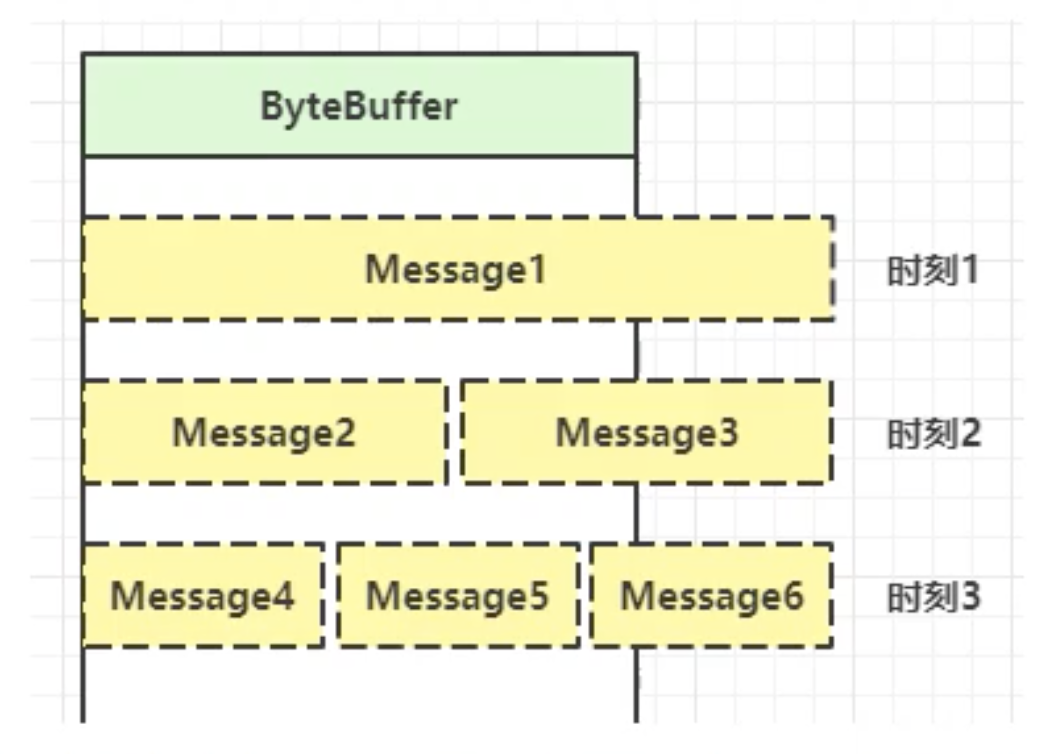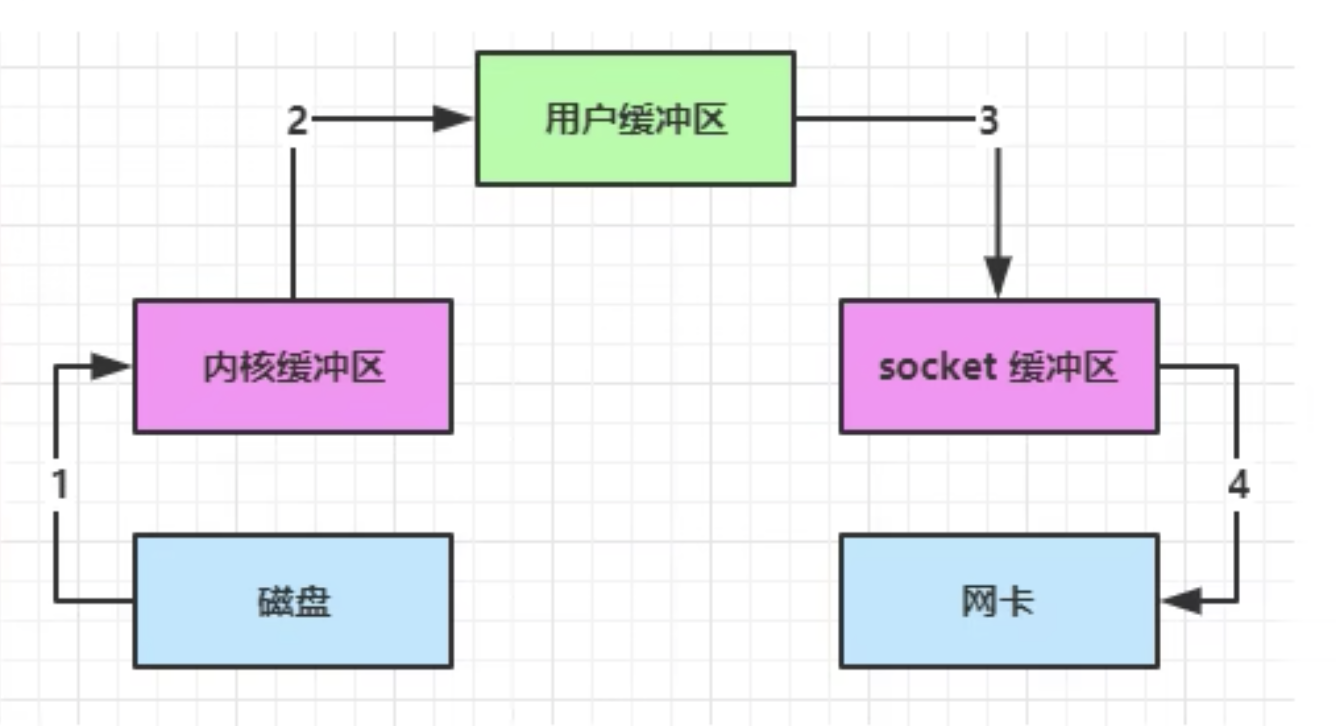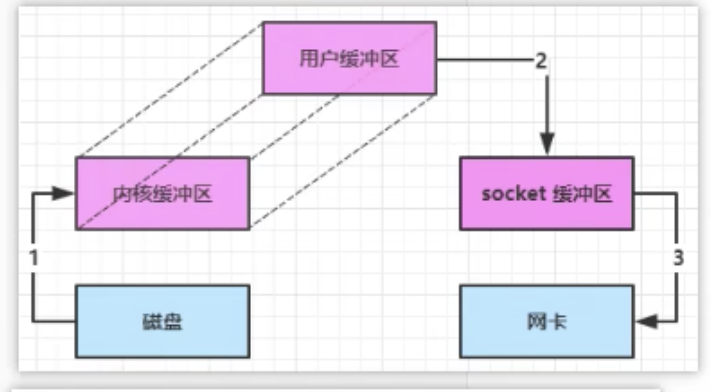前言
目前互联网环境下,分布式系统十分重要,而分布式的根基在于网络编程。Netty是java领域网络编程的佼佼者。而要学好Netty,首先就必须要会NIO编程。本笔记旨在学习NIO的概念、使用及原理,并附带一些代码实现。
- NIO三大组件
- 文件编程
- 阻塞和非阻塞的NIO网络编程
- 非阻塞多线程解决方案
概念
NIO:non-blocking io 非阻塞IO。NIO有三大组件:Channel,Bugger, Selector。
三大组件
Channel && Buffer
Channel相当与一个stream,它就是读写数据的双向通道,channel可以把数据写入buffer,也可以把数据从buffer读出。
1
2
3
| graph LR;
channel-->buffer
buffer-->channel
|
常见的channel和buffer
FileChannel
DatagramChannel
SocketChannel
ServerSocketChannel
常见的buffer:
- ByteBuffer(最常用)
- MappedByteBuffer
- DirectByteBuffer
- HeapByteBuffer
- ShortBuffer
- ……
- CharBuffer
Selector
以下是常用的几种多线程实现:
多线程版
1
2
3
4
5
6
| graph TD
subgraph 多线程版
thread1-->socket1
thread2-->socket2
thread3-->socket3
end
|
- 内存占用高
- 线程上下文切换成本高(因为CPU并发线程并没有那么多)
- 只适合连接数较小的情况
线程池
1
2
3
4
5
6
7
| graph TD
subgraph 线程池版
thread1-->socket1
thread1-.->socket3
thread2-->socket2
thread2-.->socket4
end
|
- 阻塞模式下,线程仅能处理一个socket连接
- 仅适用于短连接的场景
Selector
1
2
3
4
5
6
7
| graph TD
subgraph Selector版
thread-->selector
selector-->channel1
selector-->channel2
selector-->channel3
end
|
Selector的作用就是配合一个线程来管理多个channel,获取这些channel上发生的事件,这些channel工作在非阻塞模下,线程不会吊死在一个channel上。适合连接数多,但是流量低的场景(low traffic)。
调用selector的select()会阻塞,直到channel发生了读写就绪事件,一但这些事件发生,select方法就会赶回这些事件交给thread处理。
ByteBuffer
ByteBuffer可以理解成一个byte数组,然后封装了一些参数和API。
基本参数
- position:指针,通过指针位置来进行读写,因此同一个ByteBuffer读写模式下,position位置会不一样。
- limit:可读或可写的最大索引位置。
- capacity:ByteBuffer中数组的容量。
基本API
分配
ByteBuffer buff = ByteBuffer.allocate(int capacity):获取一个ByteBuffer ==> HeapByteBuffer,使用java堆内存
ByteBuffer buff = ByteBuffer.allocateDirect(int capacity)
- 直接内存,操作系统内存
- 分配效率差
- 操作不当容易内存泄漏
读取
byte b = buff.get():获取缓存中一个字节(pos后移)buff.get(int idx):获取指定位置的字节(pos不变)int writeBytes = channel.write(buff):从buff中读数据,通过channel写入其他
写入
buff.put(byte b) || buff.put(byte[] bs):存入字节或字节数组(pos变化)int readBytes = channel.read(buff):把channel中的数据写入buff
- 返回写入的字节数,会受到buff容量的限制
- 返回-1表示没有东西可以写了
其他
buff.flip():切换读模式(pos变0)buff.rewind():读模式下,pos置0,即从头开始读buff.clear():切换写模式(pos归零)buff.compact():切换写模式(未读内容左移到0,pos变成空白buff的起始位置)buff.mark():标记当前pos的位置buff.reset():pos回到mark的位置,还是读模式buff.hasRemaining:buff是否读完
图解
ByteBuffer buff = ByteBuffer.allocate(int capacity)
|
|
|
pos |
|
|
capacity + limit |
| a |
b |
c |
|
|
|
buffer.put(new byte[]{'a','b','c','d'})
|
|
|
|
pos |
|
capacity + limit |
| a |
b |
c |
d |
|
|
buffer.flip()buff.get() * 2buff.mark():记录pos到c的位置
|
|
pos |
|
limit |
|
capacity |
| a |
b |
c |
d |
|
|
|
|
|
|
pos+limit |
|
capacity |
| a |
b |
c |
d |
|
|
|
|
pos |
|
limit |
|
capacity |
| a |
b |
c |
d |
|
|
ByteBuffer和字符串互转
字符串转ByteBuffer
1
2
3
4
5
6
7
8
9
|
ByteBuffer buff1 = ByteBuffer.allocate(16);
buff.put("hello".getBytes());
ByteBuffer buff2 = StandardCharsets.UTF_8.encode("hello");
ByteBuffer buff3 = ByteBuffer.warp("hello".getBytes());
|
ByteBuffer转字符串
1
2
| buff.flip();
StandardCharsets.UTF_8.decode(buff).toString();
|
注意:Charset转字符串是根据pos位置来转的,因此必须要在读模式!
分散读 && 集中写
分散读
1
2
3
4
5
6
7
8
9
10
11
12
13
14
15
16
|
try(RandAccessFile file = new RandAccessFile(path, "rw")) {
FileChannel channel = file.getChannel();
ByteBuffer b1 = ByteBuffer.allocate(3);
ByteBuffer b2 = ByteBuffer.allocate(3);
ByteBuffer b3 = ByteBuffer.allocate(5);
channel.read(new ByteBuffer[]{b1, b2, b3});
b1.flip();
b2.flip();
b3.flip();
}catch(IOException e) {
...
}
|
集中写
1
2
3
4
5
6
7
8
| ByteBuffer b1 = StandardCharsets.UTF_8.encode("hello");
ByteBuffer b2 = StandardCharsets.UTF_8.encode("world");
ByteBuffer b3 = StandardCharsets.UTF_8.encode("你好!");
try(FileChannel channel = new RandAccessFile(path, "rw").getChannel()) {
channel.write(new ByteBuffer[]{b1, b2, b3});
}catch(IOException e) {
...
}
|
ByteBuffer小练习
需求描述(粘包半包)
多条数据,组合成一条消息发送给服务端,通过字符c来进行分割每条数据,服务端可能会接收到多个包(ByteBuffer[]),写一段代码,将每条数据进行打印。
解法
1
2
3
4
5
6
7
8
9
10
11
12
13
14
15
16
17
18
19
20
21
22
23
24
| public static List<String> parseMessage(ByteBuffer[] buffers, char c) {
List<String> res = new ArrayList<>();
int capacity = 0;
for (ByteBuffer byteBuffer : buffers) capacity += byteBuffer.capacity();
ByteBuffer source = ByteBuffer.allocate(capacity);
for (ByteBuffer byteBuffer : buffers) {
source.put(byteBuffer);
source.flip();
for (int j = 0; j < source.limit(); j++) {
if ((char) source.get(j) == c) {
int length = j - source.position();
ByteBuffer targetData = ByteBuffer.allocate(length);
for (int k = 0; k < length; k++) {
targetData.put(source.get());
}
source.get();
targetData.flip();
res.add(StandardCharsets.UTF_8.decode(targetData).toString());
}
}
source.compact();
}
return res;
}
|
文件编程
FileChannel
注意:只能工作在阻塞模式下
获取
不能直接打开FileChannel,必须通过FileInputStream, FileOutputStream或者RandomAccessFile来获取,通过getChannel()方法
FileInputStream获取的Channel只读
FileOutputStream获取的Channel只写
RandomAccessFile,可以控制读写权限
读取
1
2
|
int readBytes = channel.read(byteBuffer);
|
写入
正确姿势如下:(虽然FileChannel不存在这个问题,但是SocketChannel并不能一次性写入所有数据,存在写能力的上限 ===> 必须用while来判断buffer里面是否还有数据)
1
2
3
4
5
6
| ByteBuffer buffer = ...;
buffer,put(...);
buffer.flip();
while (buffer.hasRemaining()) {
channel.write(buffer);
}
|
关闭
channel必须关闭,不过调用了FileInputStream, FileOutputStream或者RandomAccessFile的close方法,会间接调用channel的close。推荐使用twr包裹,自动close。
位置
- 获取当前位置:
long pos = channel.potision()
- 设置当前位置:
channel.position(int newPos)
- 如果新位置设置在文件末尾,读取会返回-1
- 写入会进行追加,如果position超过了文件末尾,再写入新的内容和原末尾之间会有空值(00)
大小
使用size()可以 获得文件的大小
强制写入
操作系统出于性能的考虑,会将数据缓存,不是立刻写入磁盘。可以调用force(true)方法将文件内容和原数据(文件的权限等)立刻写入磁盘。
两个FileChannel之间传输数据
transferTo:返回实际传输的字节数,一次最多只能传输2GB,但效率非常高
1
2
3
4
5
6
7
8
9
10
11
12
13
| try (
FileChannel from = new FileInputstream(path).getChannel();
FileChannel to = new FileOutputStream(path).getChannel();
) {
long size = from.size();
for(long left = size; left > 0;) {
left -= from.transferTo((size - left), left, to);
}
from.transferTo(0, from.size(), to);
} catch (IOException e) {
e.printStackTrace();
}
|
Path
JDK7引入的Path和Paths
- Path表示文件路径
- Paths是工具类,用来获取Path实例
1
2
3
4
| Path source = Paths.get("cxy.txt");
Path source = Paths.get("d:\\cxy.txt");
Path source = Paths.get("d:/cxy.txt");
Path source = Paths.get("d:\\data", "cxy.txt");
|
- 支持:
./和../来表示文件层级
path.normaliaze()可以把文件路径格式化
1
2
3
| Path source = Paths.get("d:/data/test/../cxy.txt");
print(source);
print(source.nomalize())
|
Files
JDK7引入
基础API
- 检查文件是否存在:
Files.exists(Path path)
- 创建一级目录:
Files.createDirectory(Path path)
- 创建多级目录:
Files.createDirectories(Path path)
- 拷贝文件:
Files.copy(Path source, Path target)
- 如果文件已经存在,会报异常
- 如果要覆盖原文件:
Files.copy(source, target, StrandardCopyoption.REPLACE_EXISITING)
- 和
transforTo性能差不多
- 移动文件:
Files.move(Path source, Path target, StandardCopyOption.ATOMIC_MOVE)
- 删除文件:
Files.delete(Path target)
- 删除目录:
Files.delete(Path target)
- 如果目录内有文件,会抛异常,无法删除
- 需要先删文件再删目录
进阶API
遍历文件夹:Files.walkFileTree(Path start, FileVisitor<? super Path> visitor)
FileVisitor是一个接口,有4个方法,一般用new SimpleFileVisitor<Path>来写(可以不用全部实现,重写就行)
preVisitDirectory:进入文件夹前触发postVisitDirectory:离开文件夹前触发visitFile:访问文件时触发visitFileFailed:访问文件失败时触发
1
2
3
4
5
6
7
8
9
10
11
12
13
14
15
16
17
18
19
20
|
public static void main(String[] args) throws IOException {
final AtomicInteger fileCount = new AtomicInteger();
final AtomicInteger directorCount = new AtomicInteger();
Files.walkFileTree(Paths.get("/Users/memoforward/Blog/MemoForward"), new SimpleFileVisitor<Path>(){
@Override
public FileVisitResult preVisitDirectory(Path dir, BasicFileAttributes attrs) throws IOException {
directorCount.incrementAndGet();
return super.preVisitDirectory(dir, attrs);
}
@Override
public FileVisitResult visitFile(Path file, BasicFileAttributes attrs) throws IOException {
fileCount.incrementAndGet();
return super.visitFile(file, attrs);
}
});
System.out.println("files: " + fileCount.get());
System.out.println("directors: " + directorCount.get());
}
|
需求1:如何删除多级目录?
1
2
3
4
5
6
7
8
9
10
11
12
13
14
15
| public static void main(String[] args) throws IOException {
Files.walkFileTree(Paths.get("~"), new SimpleFileVisitor<Path>(){
@Override
public FileVisitResult visitFile(Path file, BasicFileAttributes attrs) throws IOException {
Files.delete(file);
return super.visitFile(file, attrs);
}
@Override
public FileVisitResult postVisitDirectory(Path dir, IOException exc) throws IOException {
Files.delete(dir);
return super.postVisitDirectory(dir, exc);
}
});
}
|
Walk
返回一个stream流。
1
2
3
4
5
6
7
8
| Files.walk(Paths.get("~")).forEach(path -> {
String targetName = path.toString().replace(source, target);
if (Files.isDirectory()) {
Files.createDirectories(Paths.get(tartetName));
} else if(Files.isRegularFile(path)) {
Files.copy(path, Paths.get(targetName));
} catch (Exception e) {...}
})
|
网络编程
阻塞式(NIO实现)
单线程处理:
1
2
3
4
5
6
7
8
9
10
11
12
13
14
15
16
17
18
19
20
21
22
23
| public static void main(String[] args) throws IOException {
ByteBuffer buffer = ByteBuffer.allocate(16);
ServerSocketChannel ssc = ServerSocketChannel.open();
ssc.bind(new InetSocketAddress(8888));
List<SocketChannel> channels = new ArrayList<>();
while (true) {
SocketChannel sc = ssc.accept();
channels.add(sc);
for (SocketChannel channel : channels) {
channel.read(buffer);
buffer.flip();
buffer.clear();
}
}
}
|
问题
以上代码,有两处地方阻塞:accept()和read()。
accept():等待客户端连接而导致的阻塞(没有线程连接就阻塞)read():等待客户端写入数据而导致的阻塞(没有数据写入就阻塞)
这就导致了:单线程处理连接,如果同时有两个线程进行连接和写入,不同线程的accpet()和read()会相互阻塞,如果一个客户端连接后,一直不写,这个线程就永远无法与其他客户端连接。
结论
阻塞式单线程处理,无法进行处理多个连接的情况。
非阻塞式(NIO Channel实现)
单线程处理:
1
2
3
4
|
ssc.configureBlocking(false);
ssc.configureBlocking(false);
|
改进版本:
1
2
3
4
5
6
7
8
9
10
11
12
13
14
15
16
17
18
19
20
21
22
23
24
25
26
27
28
29
| public static void main(String[] args) throws IOException {
ByteBuffer buffer = ByteBuffer.allocate(16);
ServerSocketChannel ssc = ServerSocketChannel.open();
ssc.configureBlocking(false);
ssc.bind(new InetSocketAddress(8889));
List<SocketChannel> channels = new ArrayList<>();
while (true) {
SocketChannel sc = ssc.accept();
if (sc != null) {
sc.configureBlocking(false);
channels.add(sc);
}
for (SocketChannel channel : channels) {
int read = channel.read(buffer);
if(read > 0) {
buffer.flip();
buffer.clear();
}
}
}
}
|
问题
- 非阻塞模式可以让线程不阻塞,但很消耗资源,相当于线程一直空转
非阻塞式改进(Selector)
由Selector监听事件,没事件就阻塞,有事件就分配线程去运行。提高线程使用效率。
Selector
- 创建:
Selector sel = Selector.open()
- channel注册:
Selectionkey selectorKey = channel.register(sel, int ops, Object attention)
sel:绑定的Selectorops:绑定的事件(SelectionKey.XXXX)
- 0:不关注任何事件
- accept:服务端事件,有连接请求时产生的事件
(SelectionKey.OP_ACCEPT)
- connect:客户端事件,连接建立后产生的事件
(SelectionKey.OP_CONNECT)
- read:服务端事件,读事件
(SelectionKey.OP_READ)
- write:客户端时间,写事件
(SelectionKey.OP_WRITE)
- 可以用两个事件的值相加来绑定多个事件
(SelectionKey.OP_ACCEPT + SelectionKey.OP_READ)
SelectorKey:channel和selector绑定的关系具象,可以通过key获得对应的channel和绑定的事件attention:绑定在SelectorKey上的对象,用来做拓展用
- 也可以手动绑定事件:
selectionKey.interestOps(SelectionKey.OP_ACCEPT)
- 开启监听:
sel.select() —>没事件是阻塞的
SelectedKeys
概念:Selector里的keys集合,用来实时处理事件
如果有事件发生,Selector就会把事件放到SelectedKeys集合里面,我们可以通过key来获取事件,并针对事件做出相应的逻辑处理。
事件处理后,理论上需要把事件移出集合(不移除,每次SelectedKeys都会遍历到这个过期事件),但是Selector仅做了逻辑删除,所以我们最好要手动移除,而在遍历集合中要做到移除元素,需要用迭代器。
简单实现
1
2
3
4
5
6
7
8
9
10
11
12
13
14
15
16
17
18
19
20
21
22
23
24
25
| public static void main(String[] args) throws IOException {
Selector selector = Selector.open();
ByteBuffer buffer = ByteBuffer.allocate(16);
ServerSocketChannel ssc = ServerSocketChannel.open();
ssc.configureBlocking(false);
SelectionKey selectionKey = ssc.register(selector, SelectionKey.OP_ACCEPT, null);
ssc.bind(new InetSocketAddress(8787));
while(true) {
selector.select();
Iterator<SelectionKey> iterator = selector.selectedKeys().iterator();
while (iterator.hasNext()) {
SelectionKey key = iterator.next();
ServerSocketChannel channel = (ServerSocketChannel)key.channel();
SocketChannel sc = channel.accept();
}
}
}
|
注意:事件发生,必须要处理,如果不处理,集合内的事件甚至不会被逻辑删除,这就导致select永远不会阻塞,消耗cpu资源。
- 调用
key.cancel()方法,会把key逻辑删除,导致不监听任何方法(除非重新注册,可以理解成物理删除),如果不处理,或发生异常来不及处理,就一定要cancel。
问题: 好像也只是单线程处理一个事件,如何根据不同的channel执行不同的事件呢?
- 给accept获得的channel也注册到selector中
- SelectedKey可以识别自身发生的事件类型
key.isAcceptable()key.isReadable()- …..
改进版本一
1
2
3
4
5
6
7
8
9
10
11
12
13
14
15
16
17
18
19
20
21
22
23
24
25
26
27
28
29
30
31
32
33
34
35
36
37
38
| public static void main(String[] args) throws IOException {
Selector selector = Selector.open();
ServerSocketChannel ssc = ServerSocketChannel.open();
ssc.configureBlocking(false);
SelectionKey selectionKey = ssc.register(selector, SelectionKey.OP_ACCEPT, null);
ssc.bind(new InetSocketAddress(8787));
while(true) {
selector.select();
Iterator<SelectionKey> iterator = selector.selectedKeys().iterator();
while (iterator.hasNext()) {
SelectionKey key = iterator.next();
if (key.isAcceptable()) {
ServerSocketChannel channel = (ServerSocketChannel)key.channel();
SocketChannel sc = channel.accept();
sc.register(selector, SelectionKey.OP_READ, null);
continue;
}
if (key.isReadable()) {
ByteBuffer buffer = ByteBuffer.allocate(16);
SocketChannel sc = (SocketChannel) key.channel();
sc.read(buffer);
buffer.flip();
}
}
}
}
|
问题:这个代码有一个不明显的问题,就是上文提到的remove机制。
- ==前提知识==:selector中会有两个集合,一个是注册的channel集合(包含了channel和监听的事件类型,这个集合就是用来阻塞监听的),另一个是selectedKeys集合。当有事件发生时,selector会从channel集合中把对应的元素拿出来放到selectedKeys集合中,供用户处理,也就是说,这两个集合放的元素都是一样,都是key,而且一个key包含了channel + 事件。
- Set\ publicKeys: 注册进来的key
- Set\ publicSelectedKeys: 事件发生后,加入的key
- 问题原因:事件处理后,selectedKeys里面仅做了逻辑删除(具体源码未知),这个删除不会让select()监测到。
- 问题复现:虽然逻辑删除的事件不会取消select()的阻塞,但是会在遍历集合的时候遍历到这个channel,而且
isAcceptable()同样也会被触发,因此当其他事件触发时,ssc又会去accept一个channel,但这个channel是null,因此会导致空指针异常。
- 问题解决:将以上代码的注释放开就行,手动remove。
- 复盘:这个更像是NIO的一个bug。
改进版本二
上述代码有两个问题:
- 客户端异常关闭,会导致一个read事件。
- 客户端正常关闭,也会导致一个read事件。
- read事件不会得到处理(因为这个channel没法read了),会导致selectedKeys集合每次循环都会增加这个事件,因为
publicKeys里面这个事件未被处理,(所以remove了也没用,因为remove是selectedKeys集合里面的内容)。
解决:
- 用catch捕获异常,并且在异常中cancel。
- 如果
channel.read() == -1, 则cancel`。
1
2
3
4
5
6
7
8
9
10
11
12
13
| if (key.isReadable()) {
try {
ByteBuffer buffer = ByteBuffer.allocate(16);
SocketChannel sc = (SocketChannel) key.channel();
int read = sc.read(buffer);
if (read == -1) key.cancel();
buffer.flip();
} catch (Exception e) {
e.printStackTrace();
key.cancel();
}
}
|
复盘:这个也像是NIO的一个bug。
消息边界问题
NIO处理黏包半包问题。

解决思路:
- 约定Buffer容量,缺点是浪费资源
- 定义包间分割符号,利用符号进行包的提取,缺点是拆包效率低
- 约定一个报文头,表明后面的消息长度【[4byte][xxxx]】。TLV模式,Type + Length + Value。根据解析的结果分配Buffer,缺点是buffer需要提前分配,如果内容过大,影响server吞吐。
- HTTP1.1是TLV格式
- HTTP2.0 是LTV格式
第二种方法的实现就是前面的小练习的增强版。
实现(使用扩容):
1
2
3
4
5
6
7
8
9
10
11
12
13
14
15
16
17
18
19
20
21
22
23
24
25
26
27
28
29
30
31
32
33
34
35
36
37
38
39
40
41
42
| if (key.isAcceptable()) {
sc.register(selector, SelectionKey.OP_READ, ByteBuffer.allocate(4));
}
if (key.isReadable()) {
try {
ByteBuffer buffer = (ByteBuffer)key.attachment();
SocketChannel sc = (SocketChannel) key.channel();
int read = sc.read(buffer);
if (read == -1) key.cancel();
else {
split(buffer, '\n');
if (buffer.limit() == buffer.position()){
ByteBuffer newBuffer = ByteBuffer.allocate(buffer.capacity() * 2);
buffer.flip();
newBuffer.put(buffer);
key.attach(newBuffer);
}
}catch(Exception e) {...}
}
}
public static void split(ByteBuffer source, char c) {
source.flip();
for (int j = 0; j < source.limit(); j++) {
if ((char) source.get(j) == c) {
int length = j - source.position();
ByteBuffer targetData = ByteBuffer.allocate(length);
for (int k = 0; k < length; k++) {
targetData.put(source.get());
}
source.get();
targetData.flip();
}
}
source.compact();
}
|
处理写事件
写事件的监听不太好理解,这里单独用一个样例表示。
1
2
3
4
5
6
7
8
9
10
11
12
13
14
15
16
17
18
19
20
21
22
23
24
25
26
27
28
29
30
31
32
33
34
35
36
37
38
39
40
41
42
| public class WriterServer {
public static void main(String[] args) throws IOException {
ServerSocketChannel ssc = ServerSocketChannel.open();
ssc.configureBlocking(false);
Selector selector = Selector.open();
ssc.register(selector, SelectionKey.OP_ACCEPT);
ssc.bind(new InetSocketAddress(8080));
while(true) {
selector.select();
Iterator<SelectionKey> iterator = selector.selectedKeys().iterator();
while (iterator.hasNext()) {
SelectionKey key = iterator.next();
iterator.remove();
if (key.isAcceptable()) {
SocketChannel sc = ssc.accept();
sc.configureBlocking(false);
StringBuffer sb = new StringBuffer();
for (int i = 0; i< 3000000; i++) sb.append("a");
ByteBuffer buffer = Charset.defaultCharset().encode(sb.toString());
while (buffer.hasRemaining()) {
int write = sc.write(buffer);
System.out.println(write);
}
}
}
}
}
}
Console log:
261676
998124
1521840
0
0
0
0
0
73728
144632
|
1
2
3
4
5
6
7
8
9
10
11
12
13
14
15
16
17
18
19
20
| public class WriteClient {
public static void main(String[] args) throws IOException {
SocketChannel sc = SocketChannel.open();
sc.connect(new InetSocketAddress("localhost", 8080));
int count = 0;
while(true) {
ByteBuffer buffer = ByteBuffer.allocate(1024 * 1024);
count += sc.read(buffer);
System.out.println(count);
buffer.clear();
}
}
}
Console log:
130656
1161444
2200476
3000000
|
我们会发现,在非阻塞模式下, 一次写不完的数据会分多次写入,但是,在while循环里,如果buffer里的数据没有被完全传递(buffer满着),就会write一个0,这不合理,我们想把写0的时候,释放线程。
1
2
3
4
5
6
7
8
9
10
11
12
13
14
15
16
17
18
19
20
21
22
23
24
25
26
27
28
29
30
31
32
33
34
35
36
37
38
39
40
41
42
| public class WriterServer {
public static void main(String[] args) throws IOException {
ServerSocketChannel ssc = ServerSocketChannel.open();
ssc.configureBlocking(false);
Selector selector = Selector.open();
ssc.register(selector, SelectionKey.OP_ACCEPT);
ssc.bind(new InetSocketAddress(8080));
while (true) {
selector.select();
Iterator<SelectionKey> iterator = selector.selectedKeys().iterator();
while (iterator.hasNext()) {
SelectionKey key = iterator.next();
iterator.remove();
if (key.isAcceptable()) {
SocketChannel sc = ssc.accept();
sc.configureBlocking(false);
SelectionKey scKey = sc.register(selector, SelectionKey.OP_READ);
StringBuffer sb = new StringBuffer();
for (int i = 0; i < 3000000; i++) sb.append("a");
ByteBuffer buffer = Charset.defaultCharset().encode(sb.toString());
if (buffer.hasRemaining()) {
scKey.interestOps(scKey.interestOps() | SelectionKey.OP_WRITE);
scKey.attach(buffer);
}
continue;
}
if (key.isWritable()) {
ByteBuffer buffer = (ByteBuffer) key.attachment();
SocketChannel sc = (SocketChannel) key.channel();
int write = sc.write(buffer);
System.out.println(write);
if (!buffer.hasRemaining()) {
key.attach(null);
key.interestOps(key.interestOps() - SelectionKey.OP_WRITE);
}
}
}
}
}
}
|
小结
多线程优化
一个线程处理多个channel,没法释放cpu所有的核心,也没有办法进行业务区分。
解决方法:分两组选择器。
- 单线程配一个选择器(boss),专门处理accpet事件
- 创建cpu核数的selector,轮流处理read
单Worker
1
2
3
4
5
6
7
8
9
10
11
12
13
14
15
16
17
18
19
20
21
22
23
24
25
26
27
28
29
30
31
32
33
34
35
36
37
38
39
40
41
42
43
44
45
46
47
48
49
50
51
52
53
54
55
56
57
58
59
60
61
62
63
64
65
66
67
68
69
70
71
72
73
74
75
76
77
78
79
| public class MultiThreadServer {
public static void main(String[] args) throws IOException {
Thread.currentThread().setName("boss");
ServerSocketChannel ssc = ServerSocketChannel.open();
ssc.configureBlocking(false);
Selector boss = Selector.open();
ssc.register(boss, SelectionKey.OP_ACCEPT);
ssc.bind(new InetSocketAddress(8080));
Worker worker = new Worker("worker-0");
while(true) {
boss.select();
Iterator<SelectionKey> iterator = boss.selectedKeys().iterator();
while (iterator.hasNext()) {
SelectionKey key = iterator.next();
iterator.remove();
ServerSocketChannel channel = (ServerSocketChannel)key.channel();
SocketChannel sc = channel.accept();
sc.configureBlocking(false);
worker.register(sc);
}
}
}
static class Worker implements Runnable{
private Thread thread;
private Selector selector;
private String name;
private volatile boolean start = false;
private ConcurrentLinkedQueue<Runnable> queue = new ConcurrentLinkedQueue<>();
public Worker(String name) {
this.name = name;
}
public void register(SocketChannel sc) throws IOException {
if (!start) {
this.thread = new Thread(this, name);
this.selector = Selector.open();
thread.start();
start = true;
}
queue.add(() -> {
try {
sc.register(selector, SelectionKey.OP_WRITE);
} catch (ClosedChannelException e) {
e.printStackTrace();
}
});
selector.wakeup();
}
@Override
public void run() {
while (true) {
try {
selector.select();
Runnable task = queue.poll();
if (task != null) task.run();
Iterator<SelectionKey> iterator = selector.selectedKeys().iterator();
while (iterator.hasNext()) {
SelectionKey key = iterator.next();
iterator.remove();
if (key.isReadable()) {
SocketChannel channel = (SocketChannel) key.channel();
}
}
} catch (IOException e){
e.printStackTrace();
}
}
}
}
}
|
多worker
轮询
1
2
3
4
5
6
7
8
9
10
11
12
|
Worker[] workers = new Worker[Runtime.getRuntime().availableProcessors()];
for (int i = 0; i < workers.length; i++) {
workers[i] = new Worker("worker-" + i);
}
AtomicInteger workIdx = new AtomicInteger();
workers[workIdx.getAndIncrement() % workers.length].register(sc);
|
概念解析
NIO vs BIO
stream和channel
- stream不会自动缓冲数据,channel会利用系统提供的发送缓冲区,接受缓冲区(更为底层)
- stream仅支持阻塞API,channel同时支持阻塞和非阻塞,网络channel可以通过Selector实现多路复用
- 二者都是全双工的,读写可以同时
IO模型
同步阻塞,同步非阻塞,多路复用,异步阻塞(不存在),异步非阻塞。建议参考书籍《UNIX网络编程》。
当调用一次channel.read或stream.read中,会切换值操作系统内核态来完成真正的数据读取,而读取又分为两个阶段:
然后在切换回用户态。
- 阻塞IO:用户线程会等待操作系统操作,一直阻塞
- 非阻塞IO:用户线程在等待数据时不阻塞,等复制数据时才会阻塞
- 多路复用:用一个线程在等待数据时阻塞,等复制数据时来处理,乍一看和阻塞IO一样,但是这个线程可以处理多个channel,这些channel都在复制数据时才会处理,理论上不是纯串行的,更加高效
同步和异步
- 同步:线程自己去获取结果(一个线程)
- 异步:线程自己不去获取结果,而是由其他线程送结果(至少两个线程)
上述讲的三种IO模型分别是:同步阻塞,同步非阻塞,(同步)多路复用。
上面的例子worker就是异步的,但是一般异步需要指定回调方法来处理异步结果。
异步不可能阻塞,一定是非阻塞的。
异步模式(AIO)
AIO用来解决数据复制阶段的阻塞问题。
异步模型需要操作系统提供支持。这里不举例啦。有空上网找找。
零拷贝
传统拷贝
实现一个文件读,像socket写,内部流程如下:

java本身不具备IO读写的能力,因此read调用后,会从用户态切换成内核态,去调用操作系统(kernel)的读能力,将数据读入内核缓冲区。这个期间,用户的线程是阻塞的,操作系统使用DMA(Direct Memory Access)进行文件读,期间不会使用cpu。
DMA理解成硬件单元,用来解放cpu完成IO
从内核态切换成用户态,将数据从内核缓冲区读入用户缓冲区(即byte[]),这期间cpu会参与拷贝,无法利用DMA
- 调用write方法,这时候将数据从缓冲区(byte[])写入socket缓冲区,cpu会参与拷贝
- 将socket缓冲区写入网卡,这意味着又要从用户态切换为内核态,使用DMA,cpu不参与。
可以看到中间环节比较多,java的IO实际不是物理设备级别的读写,而是缓存的复制,底层的读写是操作系统完成的。
- 用户态和内核态切换了3次,很重量级
- 参与了4次数据拷贝
NIO优化
使用DirectByteBuffer,将用户缓冲区和内核缓冲区合二为一。

可以看到,避免了一次数据拷贝。
零拷贝优化
通过tansferTo,进行零拷贝,使用操作系统内存。

可以看到,不通过内核缓冲区了,这就避免了两次次内核切换和两次数据复制。
- 整个复制过程中,只有一次用户态和内核态的切换
- 参与了2次数据拷贝
- 适合小文件的传输



